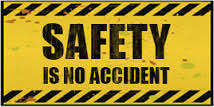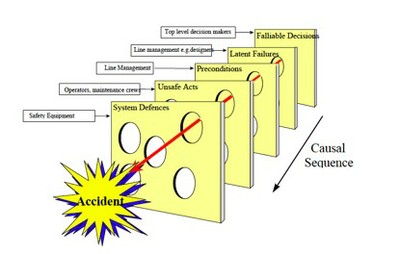
As noted earlier, motorcycle accidents are more about reducing risk probability than risk damage. The ARCS (Attitude-Readiness-Conditions-Situation) approach is a way to break down risk probabilities. It is useful because our brains handle probabilities so poorly, worrying about unlikely extreme events, like alien abduction, while ignoring how small probabilities add up. The brain also forgets that probabilities are inevitable, so they always happen eventually, e.g. you can go through a red light and get away with it often, but sooner or later the law of probability catches up. The approach here is that accidents occur when risk probabilities cumulate, based on:
Attitude: To the world around you.
Readiness: The physical state of you and your bike.
Conditions: The state of the environment around you.
Situations: The current situation you are in.
If I am in a hurry, my attitude is bad. If I have no helmet, my readiness is poor. If it is raining, conditions are bad. Finally, if someone pulls out suddenly, that is a danger situation. In general, ARCS create accidents.
Safety is no accident

Most accidents are not 100% bad luck, as there was something you could have done to prevent them. Accidents with simple causes like dangerous driving can be prevented by not driving dangerously, but accidents with many causes catch out even good riders. These are the accidents this site is about. Anyone can figure out one-cause accidents, but riding safely over time is about dealing with multi-cause accidents. The general formula is:
Risk = Attitude + Readiness + Conditions + Situation
There is also an element of luck in everything, but by definition that is something we can do nothing about.

Example: Suppose Bob is late for a meeting. He hurries to his bike and doesn’t properly clip his helmet. He speeds off without gloves, jacket or boots. Soon the sun sets and it starts to drizzle. Conditions are dark and wet. At an intersection a person in a turning car accidentally clicks the wrong turn indicator. The green light turns amber, and Bob figures to pass the turning car before the light goes red. As he passes the car, it suddenly turns the other way. He brakes, but the bike skids in the wet. He hits the car front side, and goes awkwardly over the bonnet. The road rips his skin, and as he lands, his unclipped helmet flies off. He feels a peculiar crack as his head hits the ground.
Bob wakes up in a hospital with a skull fracture and permanent road grazing scars. He thinks, “If only that stupid driver had signaled correctly!” Certainly, when the car driver clicked his indicator the wrong way, Bob’s accident was borne, but it was conceived much, much earlier. What really caused this accident? The stupid driver was the final cause, not the only cause! The real cause was that Bob was not riding safely.
What caused the accident?
Think what could have changed the outcome:
- Bob didn’t hurry: He decided right away that even though he was late, he would not hurry. So he clipped his helmet properly, wore the right gear, and did not rush the lights. He noticed the car indicated one way then turned the other way, and thought “What a Turkey!”
- Bob was ready: He wore his riding jacket and gloves. As he rode off a “helmet tug” revealed his helmet was unclipped. He stopped, and clipped it properly. In the accident, he rolled over the bonnet and walked away unhurt, without grazing or concussion, a little shaken but a lot wiser.
- Bob adapted to conditions: Seeing it was dark and wet, he slowed down accordingly. Hence the crash was much less. He didn’t go over the bonnet, but just dented things (mainly his ego).
- Bob recognized the situation: Seeing the indicator, he did not assume, but worked from real options, including a turn the other way. It was an intersection, so he slowed down, and adopted ready reaction mode. When the car starting turning the other way, he veered and halted, and with horn on, just “kissed” it. He cursed at the stupid driver.

Any the above outcomes could have happened. Bob’s hospital trauma was caused by a combination of bad attitude, poor gear, poor conditions and an unexpected situation. No one thing alone entirely “caused” the accident. Bob had ridden in a hurry before, and nothing bad had happened. He had ridden without gear before, and nothing had happened. He had ridden when dark and wet before, and nothing had happened. Once he saw someone indicate wrongly, but nothing bad happened. However when all these things combined, the result was a serious accident.
We like to say the other driver was “the cause”, but every accident has many causes, most of which you control. You control your attitude – you can choose not to hurry. You control your readiness – you can choose to wear proper gear. You control how you adapt to conditions – you can choose to ride slower in the rain. You control your ability to recognize situations – you can slow down at intersections. You have the levers in your hands that determine whether you have an accident or not. If you take hold of them, then what other people do matters less than what you do. If you choose to, you can reduce your accident chances considerably.
The accident ARC
Most accident causes occur long before the accident actually happens. For example, to hurry, to not wear protection, to ignore conditions and to not drive defensively. This is the ARC that brings us to the accident. Each person in an accident situation has his or her own ARC leading to the accident situation. The driver of the left turning car might feel the accident cause was a speeding motorcycle rider, who appeared out of nowhere. Accidents occur when ARCS intersect.
When accidents present, it is often too late to change anything. We have all seen drivers pushing hard through traffic, all acceleration and brakes, pushing their risk “envelope”. They are indeed “An accident on its way to happen”. Riding safely is not about pushing risk boundaries but about creating a safety envelope. The rest of this site tells you how to do this – how to add degrees of safety, how to improve readiness, how to adapt to weather conditions, and how to recognize risk situations. It is about avoiding accidents by reducing what causes them.